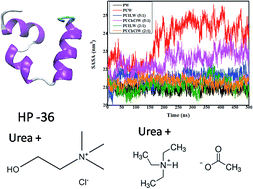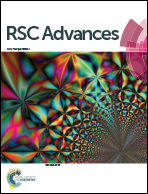Ammonium based stabilizers effectively counteract urea-induced denaturation in a small protein: insights from molecular dynamics simulations†
Abstract
Room temperature ionic liquids (IL) and deep eutectic solvents (DES) are known to aid the conformational stability and activity of proteins and enzymes in aqueous solutions. They are popular alternatives to harsh organic protecting osmolytes offsetting the thermal/chemical denaturation of proteins due to their greener attributes and low costs. In this paper, using extensive molecular dynamics (MD) simulations we show that a small helix–rich protein, chicken villin headpiece subdomain (HP-36), is rendered stable by an IL, triethylammonium acetate (TEAA) in aqueous solutions containing very high concentrations of urea (8 M). For comparison, the protein is also simulated in a deep eutectic mixture composed of 4 M choline chloride (ChCl) and 8 M urea under identical simulation conditions. Our simulations clearly show that a sharp increase in the relative proportion of TEAA (from 1 : 5 to 1 : 2 with respect to the denaturant urea) does not have a pronounced structure-enhancing effect on the protein. In contrast, for ChCl to function as an efficient protein stabilizer against the harsh action of urea, deep eutectic conditions are mandatory. To the best of our knowledge, this is the first study investigating the comparative aspects of the microscopic properties of a protein in an IL and a DES having similar ammonium-based structural frameworks.



 Please wait while we load your content...
Please wait while we load your content...